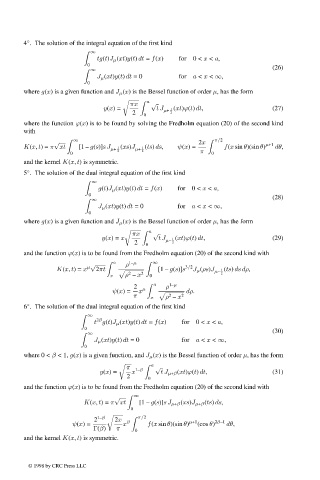Page 537 - Handbook Of Integral Equations
P. 537
◦
4 . The solution of the integral equation of the first kind
∞
tg(t)J µ (xt)y(t) dt = f(x) for 0 < x < a,
0
∞
(26)
J µ (xt)y(t) dt =0 for a < x < ∞,
0
where g(x) is a given function and J µ (x) is the Bessel function of order µ, has the form
a
πx √
y(x)= tJ µ+ 1 (xt)ϕ(t) dt, (27)
2 0 2
where the function ϕ(x) is to be found by solving the Fredholm equation (20) of the second kind
with
π/2
√ ∞ 2x
K(x, t)= π xt [1 – g(s)]s J 1 (xs)J 1 (ts) ds, ψ(x)= f(x sin θ)(sin θ) µ+1 dθ,
µ+ µ+
0 2 2 π 0
and the kernel K(x, t) is symmetric.
5 . The solution of the dual integral equation of the first kind
◦
∞
g(t)J µ (xt)y(t) dt = f(x) for 0 < x < a,
0
∞
(28)
J µ (xt)y(t) dt =0 for a < x < ∞,
0
where g(x) is a given function and J µ (x) is the Bessel function of order µ, has the form
a
πx √
y(x)= x tJ µ– 1 (xt)ϕ(t) dt, (29)
2 0 2
and the function ϕ(x) is to be found from the Fredholm equation (20) of the second kind with
a 1–µ
√ ρ ∞
K(x, t)= x µ 2πt [1 – g(s)]s 3/2 J µ (ρs)J µ– 1 (ts) ds dρ,
2
x ρ – x 2 0 2
a 1–µ
2 µ ρ
ψ(x)= x dρ.
π x ρ – x 2
2
◦
6 . The solution of the dual integral equation of the first kind
∞
2β
t g(t)J µ (xt)y(t) dt = f(x) for 0 < x < a,
0
(30)
∞
J µ (xt)y(t) dt =0 for a < x < ∞,
0
where 0 < β <1, g(x) is a given function, and J µ (x) is the Bessel function of order µ, has the form
a
π 1–β √
y(x)= x tJ µ+β (xt)ϕ(t) dt, (31)
2 0
and the function ϕ(x) is to be found from the Fredholm equation (20) of the second kind with
√ ∞
K(x, t)= π xt [1 – g(s)]s J µ+β (xs)J µ+β (ts) ds,
0
π/2
1–β
2 2x β µ+1 2β–1
ψ(x)= x f(x sin θ)(sin θ) (cos θ) dθ,
Γ(β) π 0
and the kernel K(x, t) is symmetric.
© 1998 by CRC Press LLC
© 1998 by CRC Press LLC
Page 519

